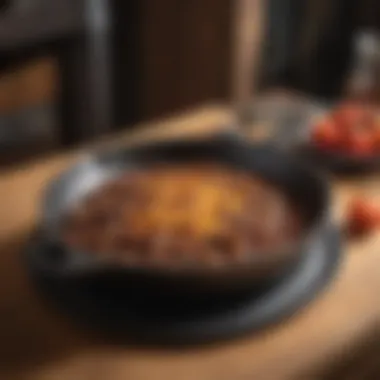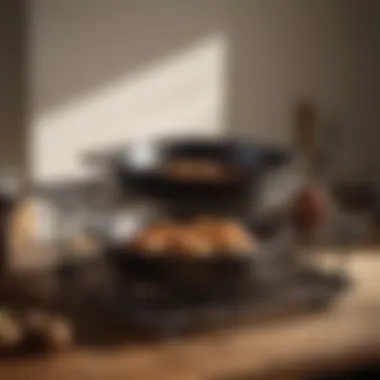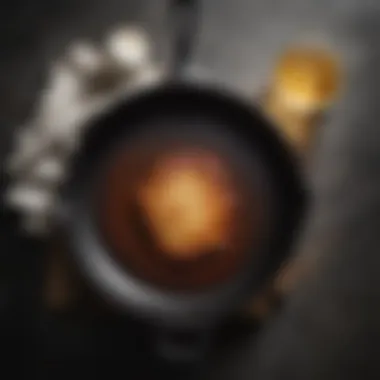Essential Techniques for Drying Cast Iron Cookware


Intro
Drying cast iron cookware is a crucial step that often goes unnoticed, yet it plays a significant role in the maintenance and usability of these cooking tools. Cast iron is favored for its heat retention and even cooking properties, but without proper care, it can easily succumb to rust and deterioration.
This guide will explore effective methods for drying cast iron cookware while emphasizing the importance of these practices. Readers will learn not just the hows, but also the whys behind each technique. By following the insights provided, one can ensure their cast iron pieces remain in top condition for many years.
Understanding the Importance of Proper Drying
Proper drying is essential for several reasons. First, it prevents rust, which can form when moisture lingers on cast iron surfaces. Second, maintaining the seasoning layer is key to the performance of these pans. Seasoning not only enhances flavor but also provides a natural non-stick surface.
"If cast iron cookware is not dried correctly, the consequences are twofold: potential rust forms and the seasoning may be compromised, making the cookware less effective."
Best Practices for Drying Cast Iron Cookware
When it comes to drying your cast iron cookware, specific methods yield the best results. Here are some preferred techniques:
- Immediate Drying: After washing, use a towel to dry the skillet just after rinsing. The sooner the cookware dries, the lower the risk for rust.
- Stovetop Heating: Place the cookware on low heat for several minutes. This technique evaporates any residual moisture quickly.
- Oven Drying: For a thorough drying process, place the cookware in an oven preheated to a low temperature for about 10-15 minutes. Ensure to place it upside down to avoid trapping moisture.
- Oil Application: After drying, apply a light coat of oil to the surface. This helps to protect the seasoning from degradation and provides a barrier against moisture.
Final Thoughts on Cast Iron Care
The practice of drying cast iron cookware is more than just a chore; it's a step that ensures longevity and functionality. When done properly, it not only enhances your cooking experience but also adds to the durability of the cookware. By integrating these practices into your routine, you can confidently maintain your cast iron and maximize its use in various culinary applications.
Importance of Drying Cast Iron
Drying cast iron cookware is not just a routine task; it is a crucial step in ensuring the longevity and effectiveness of your kitchen essentials. The unique properties of cast iron make it a popular choice among cooking enthusiasts. It retains heat well and provides a non-stick surface when properly seasoned. However, these benefits come with responsibilities, one of which is ensuring your cookware is thoroughly dried after washing.
Understanding Cast Iron
Cast iron is a material that has been utilized for centuries due to its cooking advantages. The material is porous, which can absorb moisture if not appropriately handled. When water is left standing, it seeps into the surface, which can lead to issues like rust and compromised seasoning. Recognizing the structure of cast iron will help you appreciate the necessity of proper care.
Caring for cast iron involves understanding its capacity to hold flavors while also requiring a specific routine to maintain its integrity. When properly maintained, cast iron can outperform many modern alternatives, given its superior heat retention and distribution.
Consequences of Improper Drying
Failing to dry cast iron cookware can result in serious drawbacks, primarily rust formation. Rust can quickly ruin the surface, making it necessary to strip and re-season the pan, which is labor-intensive and time-consuming. Furthermore, moisture can dilute the seasoning layer, leading to a sticky or uneven cooking surface.
Additionally, when water is left on the pan, it can create a breeding ground for bacteria. Although cast iron generally has a naturally non-stick surface when seasoned, the presence of moisture creates an environment that can negatively impact food safety.
In summary, neglecting the drying process constitutes a direct threat to the lifespan and performance of cast iron cookware. Proper drying is not merely about removing excess water; it is about ensuring that your cooking tools remain effective and safe for use.
In essence, the drying process is just as important as seasoning and usage when it comes to maintaining cast iron cookware.
By understanding the significance of drying and implementing proper techniques, cooks can preserve their valuable cast iron collection for generations.
Preparing for the Drying Process


Preparing for the drying process of cast iron cookware is a fundamental step that should not be overlooked. Proper preparation ensures that the cookware remains in excellent condition, preventing rust and maintaining its seasoning. Understanding this process allows for a smoother experience and better results. Every cooking enthusiast should recognize that the methods employed during this phase can significantly influence the cookware's performance and longevity.
A few specific elements play an important role in the preparation stage. First, having the right tools at hand can streamline the entire drying process. Secondly, ensuring that the cookware is clean before drying is crucial. Residual food particles or moisture can lead to complications.
By addressing each component of the preparation process, the user can establish a thorough routine. This routine will include the examination of tools needed and the proper cleaning techniques that are essential. Ultimately, preparation sets the groundwork for effective drying and successful future use of cast iron cookware.
Essential Tools Required
Before beginning the drying process, certain tools are essential to ensure efficiency and effectiveness. These simple tools facilitate different methods of drying and cleaning that enhance the overall care of cast iron. Here’s a brief list of what you will need:
- Paper towels or clean cloths: For drying the surface thoroughly after washing.
- Heat source: This can be a stovetop or an oven, depending on the method chosen.
- Non-abrasive scrub brush or sponge: For cleaning any stuck food particles without damaging the seasoning.
- Cookware oil (like vegetable oil): For re-seasoning the cookware post-drying.
- Baking sheet or tray: This is useful for catching drips while drying in the oven.
Having these tools ready will make the drying process much smoother.
Cleaning Cast Iron Before Drying
Cleaning cast iron before drying is an essential step that directly impacts the effectiveness of the drying process. The adherence of food residues or grime to the surface can create problems. It is vital to clean the cast iron properly to avoid any rust formation or seasoning degradation.
To clean the cast iron:
- Rinse it under hot water. Avoid using soap as it can strip seasoning.
- If necessary, use a non-abrasive sponge or brush to scrub any stubborn bits away.
- Dry the cookware immediately with a paper towel or a cloth to prevent moisture from sitting on the surface for too long.
By following these steps, you ensure that all surfaces are clean, giving the cookware the best chance to dry efficiently. Proper cleaning is a key preparation step for ensuring the longevity and functionality of cast iron cookware.
Methods for Drying Cast Iron
Understanding the methods for drying cast iron cookware is essential for maintaining its quality and usability. Each method has its own advantages and might suit different situations. Choosing the right drying technique can impact the performance of your cookware, especially concerning rust prevention and seasoning retention. A well-dried pan is also crucial for health, as moisture can harbor bacteria and cause spoilage.
The goal of this section is to outline effective methods, consider their benefits, and discuss any notable aspects involved with each approach.
Air Drying Technique
Air drying is a straightforward and natural method. After washing your cast iron with mild soap and water, simply place it upside down on a drying rack. This technique allows air to circulate around the cookware, facilitating a slow and even drying process.
Key Points to Consider:
- Duration: This method can take several hours to complete, depending on the humidity of your environment.
- Tips: Place a cloth under the rack to catch any dripping water.
- Effectiveness: Though convenient, air drying might not completely eliminate moisture, particularly in humid conditions. This can lead to rust, so ensure it is a suitable option for your environment.
Stove Top Drying Method
The stove top drying method is a quicker approach to remove moisture. After washing, place the cast iron pan on the stove over low heat. Allow it to warm for several minutes to evaporate any remaining water.
Advantages:
- Speed: This method is much faster than air drying, often achieving results in five to ten minutes.
- Control: You can easily monitor the pan and ensure that it is completely dry without overcooking.
- Safety: Make sure to keep the heat low to avoid damaging the seasoning layer.
Oven Drying Process


Drying in the oven is another effective method. Preheat your oven to a low temperature, around 200°F (93°C). Once heated, place the cast iron cookware upside down on a middle rack. The warm air will circulate around the pan, evaporating moisture thoroughly.
Considerations:
- Even Drying: This method is effective and ensures even evaporation of moisture.
- Timing: Allow the oven to run for about an hour. Use oven mitts to remove the pan safely, as it will be quite hot.
- Energy Use: Keep in mind that using the oven may consume more energy compared to the other methods discussed.
Using Heat to Speed Up Drying
Combining heat with any of the above methods is a wise strategy to accelerate drying. For example, you can air dry the cast iron for a bit and then finish the process using the stove top technique. This combination ensures thorough drying while protecting the cookware from rust.
Best Practices:
- Transition: Use heat after air drying for optimal results.
- Monitoring: Stay vigilant while using heat to avoid overheating or damaging the pan.
- Final Check: Before storing, always check for any residual dampness to ensure longevity of the cookware.
"A well-maintained cast iron skillet can last for generations. Proper drying methods help ensure that these durable pieces remain usable and effective."
In summary, choosing the right drying method greatly influences the longevity and performance of cast iron cookware. Each method has its unique advantages, and understanding them allows for informed decisions on how best to care for your kitchen investment.
Best Practices After Drying
After drying cast iron cookware, it is essential to follow best practices to ensure long-lasting usage and maintain its performance. Proper care after drying not only extends the life of the cookware but also preserves the seasoning, preventing any rust from forming. This section will delve into two fundamental practices: applying oil and storage tips. Both of these elements directly contribute to retaining the integrity of cast iron and making sure that it remains a valuable kitchen tool.
Applying Oil After Drying
Applying oil to cast iron cookware after it has dried is a vital step in maintaining its well-being. This practice replenishes the seasoning layer, which protects against moisture and rust. Here are some key benefits of this method:
- Protection from Rust: Oil creates a barrier against moisture. If the pan has been thoroughly dried, a thin layer of oil helps seal in that dryness, maintaining the surface.
- Enhanced Non-Stick Surface: Regular oil application builds up the seasoning layer. This enhances the non-stick properties, making cooking and cleaning easier.
- Improved Maintenance: A well-oiled pan is not just about cooking better, but it is also about reduced hassle during cleaning and maintaining.
To effectively apply oil, choose a high-smoke point oil such as grapeseed, canola, or flaxseed oil. These oils are less likely to become tacky over time. Use a clean cloth or paper towel to spread a light coat of oil over the entire surface of the cookware, including the handle and exterior. Ensure that all areas are evenly coated, but avoid excess oil, as a thick layer can lead to stickiness.
Storage Tips for Cast Iron
Proper storage is equally as important as applying oil after drying. This ensures that the precious coating you've nurtured remains intact and functioning. To store cast iron cookware efficiently, consider the following tips:
- Cool Before Storing: Always let the cookware cool completely to avoid moisture accumulation.
- Avoid Stacking Damp Cookware: If storing multiple pieces, ensure they are thoroughly dry. Placing damp cookware on top of each other can trap moisture.
- Use a Barrier: Place a paper towel or cloth between stacked items. This absorbs any moisture and keeps surfaces from scratching against each other.
- Choose a Dry Storage Area: Opt for a cool and dry place, away from humidity. A cupboard or cabinet works best.
Maintaining cast iron cookware is about having the right techniques in place. Even after drying, consistent care through oil application and proper storage is essential for longevity.
By following these best practices, users can effectively preserve the quality and performance of their cast iron cookware. This mindful approach ensures that seasoned cast iron remains a reliable companion in the kitchen for years to come.
Common Mistakes to Avoid
When it comes to drying cast iron cookware, understanding common mistakes is fundamental. These errors can significantly affect the cookware's longevity and performance. Here, we address two specific missteps that many users encounter: neglecting the drying process and using excessive water for cleaning.
Neglecting the Drying Process
One of the most critical errors is bypassing the drying process altogether. Cast iron is porous, which means that not drying it properly can lead to trapped moisture. This trapped moisture fosters rust, compromising not just the pan's surface but also its overall functionality. Failure to dry your cast iron cookware correctly can also disrupt the seasoning layer, which is vital for non-stick properties and preventing food from sticking.


To illustrate, consider that moisture left on the surface can oxidize the iron over time. This oxidation leads to flaking rust, making the cookware less appealing and unusable. Therefore, prioritizing the drying step is essential. Making a habit of thoroughly drying cast iron immediately after cleaning can greatly enhance its usability for accurate cooking.
Using Excessive Water for Cleaning
Another common pitfall is the overuse of water during the cleaning process. While it’s important to remove food residues and build-up, too much water can wash away necessary oils from the seasoning layer. Water can seep into the pores of the cast iron, rendering the pan vulnerable to rust formation.
Using excess water often leads to two main issues:
- Seasoning Removal: Excess water can strip the pan of its seasoning, which is formed by layers of oil baked onto the surface. This layer is crucial for creating a non-stick surface and protecting the pan from moisture.
- Rust Formation: Persistent excess moisture can initiate rusting, which deteriorates the pan and demands more maintenance.
Instead, consider using minimal water when cleaning, and opt for methods such as scraping or utilizing a cloth to wipe down any residues. In addition, always dry immediately after cleaning to mitigate risks of rust.
"A well-maintained cast iron pan is a reliable kitchen companion. Avoiding common mistakes ensures its longevity."
In summary, avoiding these mistakes can significantly influence the performance and durability of your cast iron cookware. Understanding the importance of the drying process and being cautious with water usage will help in maintaining a finely seasoned and functional pan.
Maintaining Cast Iron for Longevity
Maintaining cast iron cookware is essential for anyone who values their culinary tools. The investment you make in quality cast iron can yield significant benefits, provided you follow proper care practices. Regular maintenance not only extends the lifespan of the cookware but also enhances its performance over time. When treated well, cast iron pans can become family heirlooms, passed down through generations.
Regular Seasoning Practices
Seasoning involves applying a layer of oil to the cast iron surface and baking it, forming a non-stick coating. This not only protects the iron from rust but also creates a surface that improves with use. To maintain the seasoning:
- Choose the Right Oil: Flaxseed oil, grapeseed oil, and canola oil are excellent choices due to their high smoke points. They form a durable layer when heated.
- Apply Thin Layers: Too much oil can lead to a sticky residue. A very thin coat is ideal. Wipe excess oil using a paper towel.
- Heat Properly: Preheat your oven to around 450°F (232°C), and place the cookware upside down with a baking sheet below to catch drips. Bake for at least one hour.
In addition, consider re-seasoning your cookware after several uses or if you notice food starting to stick. Maintaining a good seasoning layer ensures ease of cooking and cleaning, allowing for a more pleasurable cooking experience.
Avoiding Rust Through Proper Care
Rust can be a constant threat to cast iron if proper care is not taken. To avoid this:
- Dry Immediately: Always dry your cast iron cookware immediately after washing. Use a towel, or briefly heat it on the stove to evaporate any moisture.
- Store in a Dry Place: Ensure your storage area is devoid of excess humidity. A dry cupboard or shelf is best for preventing moisture accumulation.
- Use a Light Coat of Oil: After drying, applying a very light coat of cooking oil helps create a barrier against moisture.
Proper care is not just about preventing rust; it also enhances the non-stick properties of your cast iron cookware.
By following these practices, you can help secure the longevity of your cast iron cookware, maximizing its utility and ensuring its place in your kitchen for many years to come.
Culmination
In the context of drying cast iron cookware, concluding the narrative carries significant weight. It serves as a moment to reflect on the practices discussed and reinforce the essential role that proper drying plays in maintaining the integrity of the cookware. Proper drying not only extends the lifespan of cast iron but also ensures that its seasoning remains effective, protecting the surface from rust and wear.
The Benefits of Proper Drying
By emphasizing the correct techniques, one can safeguard against the deterioration common in improperly maintained cookware. Well-dried cast iron is less prone to moisture retention, which is crucial in environments susceptible to humidity. Over time, neglect can lead to irreversible damage, ultimately requiring costly replacements or restoration efforts.
Considerations to Keep in Mind
When concluding, it is vital to remind readers that simplicity is key. While the cleaning and drying process may involve multiple steps, maintaining a regular routine should not feel overwhelming. Instead, readers should see it as a commitment to their culinary tools, ensuring optimal performance for every meal prepared.
Proper drying techniques form the backbone of maintaining a cast iron piece that is not only functional but also a joy to use.
In summary, the vital importance of drying cast iron cookware cannot be overstated. The careful application of drying methods strengthens the cookware’s seasoning and prevents rust, allowing it to serve as a reliable companion in the kitchen for years to come.
Recap of Key Points
- Importance of Drying: Accurate drying preserves the seasoning and prevents rust, thereby extending the life of the cookware.
- Methods Discussed: Various techniques include air drying, stove top drying, and oven drying, each suited for different circumstances and convenience levels.
- Best Practices: Regular oil application post drying and adequate storage practices ensure cleanliness and readiness for immediate use.
- Mistakes to Avoid: Neglecting drying and using too much water during cleaning can significantly compromise the longevity of cast iron.
- Ongoing Maintenance: Regular seasoning practices will also enhance the durability and usability of cast iron cookware.







